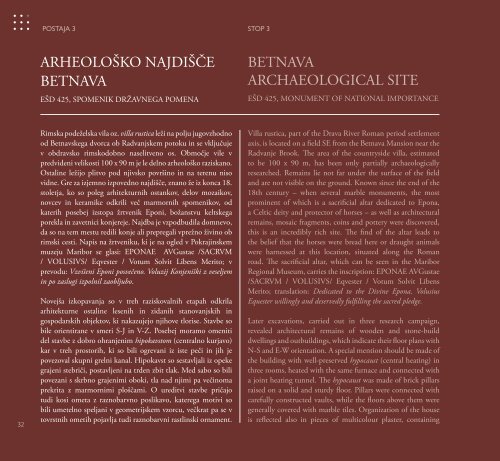Arheološka pot po Mariboru z okolico ... - Življenje na dotik
Arheološka pot po Mariboru z okolico ... - Življenje na dotik
Arheološka pot po Mariboru z okolico ... - Življenje na dotik
Create successful ePaper yourself
Turn your PDF publications into a flip-book with our unique Google optimized e-Paper software.
32<br />
POSTAJA 3<br />
ARHEOLOŠKO NAJDIŠČE<br />
BETNAVA<br />
EŠD 425, SPOMENIK DRŽAVNEGA POMENA<br />
Rimska <strong>po</strong>deželska vila oz. villa rustica leži <strong>na</strong> <strong>po</strong>lju jugovzhodno<br />
od Bet<strong>na</strong>vskega dvorca ob Radvanjskem <strong><strong>po</strong>t</strong>oku in se vključuje<br />
v obdravsko rimskodobno <strong>na</strong>selitveno os. Območje vile v<br />
predvideni velikosti 100 x 90 m je le delno arheološko raziskano.<br />
Ostaline ležijo plitvo <strong>po</strong>d njivsko <strong>po</strong>vršino in <strong>na</strong> terenu niso<br />
vidne. Gre za izjemno iz<strong>po</strong>vedno <strong>na</strong>jdišče, z<strong>na</strong>no že iz konca 18.<br />
stoletja, ko so <strong>po</strong>leg arhitekturnih ostankov, delov mozaikov,<br />
novcev in keramike odkrili več marmornih s<strong>po</strong>menikov, od<br />
katerih <strong>po</strong>sebej izstopa žrtvenik E<strong>po</strong>ni, božanstvu keltskega<br />
<strong>po</strong>rekla in zavetnici konjereje. Najdba je vz<strong>po</strong>dbudila domnevo,<br />
da so <strong>na</strong> tem mestu redili konje ali prepregali vprežno živino ob<br />
rimski cesti. Napis <strong>na</strong> žrtveniku, ki je <strong>na</strong> ogled v Pokrajinskem<br />
muzeju Maribor se glasi: EPONAE AVGustae /SACRVM<br />
/ VOLUSIVS/ Eqvester / Votum Solvit Libens Merito; v<br />
prevodu: Vzvišeni E<strong>po</strong>ni <strong>po</strong>svečeno. Voluzij Konjeniški z veseljem<br />
in <strong>po</strong> zaslugi iz<strong>po</strong>lnil zaobljubo.<br />
Novejša izkopavanja so v treh raziskovalnih etapah odkrila<br />
arhitekturne ostaline lesenih in zidanih stanovanjskih in<br />
gos<strong>po</strong>darskih objektov, ki <strong>na</strong>kazujejo njihove tlorise. Stavbe so<br />
bile orientirane v smeri S-J in V-Z. Posebej moramo omeniti<br />
del stavbe z dobro ohranjenim hi<strong>po</strong>kavstom (centralno kurjavo)<br />
kar v treh prostorih, ki so bili ogrevani iz iste peči in jih je<br />
<strong>po</strong>vezoval skupni grelni ka<strong>na</strong>l. Hi<strong>po</strong>kavst so sestavljali iz opeke<br />
grajeni stebriči, <strong>po</strong>stavljeni <strong>na</strong> trden zbit tlak. Med sabo so bili<br />
<strong>po</strong>vezani s skrbno grajenimi oboki, tla <strong>na</strong>d njimi pa večinoma<br />
prekrita z marmornimi ploščami. O ureditvi stavbe pričajo<br />
tudi kosi ometa z raznobarvno <strong>po</strong>slikavo, katerega motivi so<br />
bili umetelno speljani v geometrijskem vzorcu, večkrat pa se v<br />
tovrstnih ometih <strong>po</strong>javlja tudi raznobarvni rastlinski or<strong>na</strong>ment.<br />
STOP 3<br />
BETNAVA<br />
ARCHAEOLOGICAL SITE<br />
EŠD 425, MONUMENT OF NATIONAL IMPORTANCE<br />
Villa rustica, part of the Drava River Roman period settlement<br />
axis, is located on a field SE from the Bet<strong>na</strong>va Mansion near the<br />
Radvanje Brook. The area of the countryside villa, estimated<br />
to be 100 x 90 m, has been only partially archaeologically<br />
researched. Remains lie not far under the surface of the field<br />
and are not visible on the ground. Known since the end of the<br />
18th century – when several marble monuments, the most<br />
prominent of which is a sacrificial altar dedicated to E<strong>po</strong><strong>na</strong>,<br />
a Celtic deity and protector of horses – as well as architectural<br />
remains, mosaic fragments, coins and <strong><strong>po</strong>t</strong>tery were discovered,<br />
this is an incredibly rich site. The find of the altar leads to<br />
the belief that the horses were bread here or draught animals<br />
were harnessed at this location, situated along the Roman<br />
road. The sacrificial altar, which can be seen in the Maribor<br />
Regio<strong>na</strong>l Museum, carries the inscription: EPONAE AVGustae<br />
/SACRVM / VOLUSIVS/ Eqvester / Votum Solvit Libens<br />
Merito; translation: Dedicated to the Divine E<strong>po</strong><strong>na</strong>. Volusius<br />
Equester willingly and deservedly fulfilling the sacred pledge.<br />
Later excavations, carried out in three research campaign,<br />
revealed architectural remains of wooden and stone-build<br />
dwellings and outbuildings, which indicate their floor plans with<br />
N-S and E-W orientation. A special mention should be made of<br />
the building with well-preserved hy<strong>po</strong>caust (central heating) in<br />
three rooms, heated with the same fur<strong>na</strong>ce and connected with<br />
a joint heating tunnel. The hy<strong>po</strong>caust was made of brick pillars<br />
raised on a solid and sturdy floor. Pillars were connected with<br />
carefully constructed vaults, while the floors above them were<br />
generally covered with marble tiles. Organization of the house<br />
is reflected also in pieces of multicolour plaster, containing<br />
Med drobnimi <strong>na</strong>jdbami prevladuje keramično <strong>po</strong>sodje, ki <strong>po</strong><br />
svojih z<strong>na</strong>čilnostih skupaj z novci sodi v ohlapno opredeljen<br />
časovni okvir med drugo <strong>po</strong>lovico 3. stoletja in drugo <strong>po</strong>lovico<br />
4. stoletja n. št. Iz tega časa se je ohranilo kar 60 novcev, odkritih<br />
ob stebričku znotraj hi<strong>po</strong>kavsta, tako da smemo govoriti o t. i.<br />
zakladni oz. de<strong>po</strong>jski <strong>na</strong>jdbi. Datacijsko iz<strong>po</strong>vednost novčnih<br />
<strong>na</strong>jdb <strong><strong>po</strong>t</strong>rjuje tudi preostalo drobno gradivo kot so fibula<br />
s čebulastimi zaključki, ledvičasto oblikova<strong>na</strong> pas<strong>na</strong> s<strong>po</strong><strong>na</strong>,<br />
odlomki steklenih predmetov in drugo.<br />
Hi<strong>po</strong>kavst v času odkritja<br />
(vir: arhiv ZVKDS).<br />
Hy<strong>po</strong>caust at the time of its discovery<br />
(source: the ZVKDS archives).<br />
intricate geometric motifs, whereas recurrent multicolour plant<br />
or<strong>na</strong>ments are also often observed on plasters of this kind.<br />
Pottery present the majority of archaeological finds and<br />
according to their characteristics they – together with coins –<br />
belong to the loosely defined time period between the second<br />
half of the 3rd century and the second half of the 4th century<br />
AD. As many as 60 coins, discovered at a pillar inside the<br />
hy<strong>po</strong>caust, which allows us to talk about the so-called hoard<br />
find, have been preserved from that period. Dating of the coins<br />
is confirmed also by other finds, such as a crossbow fibula, a<br />
kidney-shaped belt buckle, fragments of glass items, etc.<br />
Rimski novci, <strong>na</strong>jdeni ob stebričku hi<strong>po</strong>kavsta<br />
(vir: arhiv ZVKDS).<br />
Roman coins found next to a hy<strong>po</strong>caust pillar<br />
(source: the ZVKDS archives).


